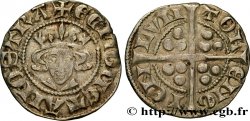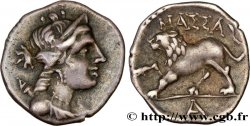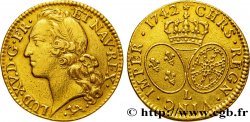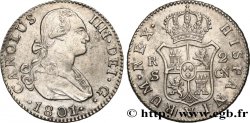Live auction - fme_471341 - LUIS XVIII Médaille, Général La Fayette
Usted debe firmar y ser un comprador aprobado para pujar, Inicia sesión para pujar. Las cuentas están sujetas a la aprobación y el proceso de aprobación se alcanzan dentro de las 48 horas. No espere hasta el día en una venta se cierra el registro.Al hacer una oferta en este artículo usted está firmando un contrato jurídicamente vinculante para comprar este artículo y haga clic en «oferta» constituye una aceptación de los términos de uso de live auctions de cgb.fr.
La subasta debe ser colocado en euros enteros cantidades venta only.The se cerrará en el momento en la descripción del artículo, no se ejecutarán las ofertas recibidas en el sitio después de la hora de cierre. Veces Transmition pueden variar y las ofertas pueden ser rechazadas si espera a los últimos segundos. Para más información envie el FAQ Live auction.
Las ofertas ganadoras estarán sometidas a un 18% IVA incluido por gastos de participación a la venta.
Las ofertas ganadoras estarán sometidas a un 18% IVA incluido por gastos de participación a la venta.
| Valoración : | 250 € |
| Precio : | no oferta |
| Oferta más alta : | no oferta |
| Fecha de fin de la venta : | 30 octubre 2018 17:35:42 |
Tipo : Médaille, Général La Fayette
Fecha: 1824
Metal: bronce
Diámetro: 46,5 mm
Eje de acuñación: 12 h.
Acuñador CAUNOIS François Augustin (1787-1859)
Peso: 49,17 g.
Canto: lisse
Comentarios sobre el estado de conservación:
Traces de nettoyage. Présence de rayures dans les champs
N° en los catálogos de referencia :
Anverso
Titulatura del anverso: GENERAL - LAFAYETTE.
Descripción del anverso: Buste du général La Fayette, en habit, à droite ; sur la tranche de l’épaule .1824. ; au-dessous signature CAUNOIS FRENCH..
Reverso
Titulatura del reverso: THE DEFENDER / OF AMERICAN AND / FRENCH LIBERTY. / 1777-1824. / BORN IN CHAVANIAC, / THE 6 SEPTEMBER, / 1757..
Descripción del reverso: Couronne de chêne, inscription au centre en sept lignes.
Comentario
Signature CAUNOIS FRENCH. au droit. Cette médaille a certainement été réalisée pour les États-Unis ; elle existe aussi en bronze doré ou en bronze argenté et en or.
Cette médaille commémore le voyage de La Fayette aux États-Unis le 13 juillet 1824. Collignon (La médaille au XIXe siècle et l’histoire) décrit ainsi ce voyage “Après avoir fait un triomphal accueil à Lafayette, qui était allé revoir le théâtre des exploits de sa jeunesse, le Congrès des États-Unis avait voté une résolution où il appelait Lafayette le champion de la liberté, le héros de la Révolution, l’ami et le compagnon de Washington, et il avait envoyé un navire de guerre le chercher en France. Le Vice-Président vint le recevoir à New-York. Il fut traité dans toutes les cités américaines avec les mêmes honneurs que s’il eut été le président d’une République Française. Les récits émouvants qui arrivaient d’Amérique apportèrent aux libéraux français une consolation, un encouragement et une espérance”. Lafayette effectue ce voyage avec son fils prénommé Georges Washington, 182 villes sont visitées entre 1824 et 1825. Le Congrès le remercie en lui faisant un don de 200.000 dollars (en récompense de l’argent qu’il avait avancé personnellement pour aider la Révolution américaine) et 12.000 hectares de terres en Floride. Il fut le premier étranger à s'adresser aux deux Chambres réunies du Congrès américain et son portrait figure dans la Chambre des Représentants. Il a été élevé à titre posthume, «citoyen d'honneur des États-Unis d'Amérique», un privilège rare qui n’a été accordé qu'à quatre reprises dans l'Histoire américaine.
Signature CAUNOIS FRENCH. to the obverse. This medal was certainly made for the United States; it also exists in gilded bronze or silvered bronze and gold.
This medal commemorates Lafayette's trip to the United States on July 13, 1824. Collignon (The Medal in the 19th Century and History) describes this journey as follows: “After giving a triumphant welcome to Lafayette, who had gone to revisit the scene of the exploits of his youth, the United States Congress had voted a resolution in which it called Lafayette the champion of liberty, the hero of the Revolution, the friend and companion of Washington, and it had sent a warship to fetch him from France.. The Vice President came to receive him in New York. He was treated in all American cities with the same honors as if he had been the president of a French Republic.. The moving stories that arrived from America brought consolation, encouragement and hope to the French liberals.. Lafayette made this trip with his son, George Washington, and visited 182 cities between 1824 and 1825.. Congress thanks him with a donation of 200. 000 dollars (as a reward for the money he had personally advanced to aid the American Revolution) and 12. 000 hectares of land in Florida. He was the first foreigner to address both houses of the United States Congress together, and his portrait appears in the House of Representatives.. He was posthumously made an \\\"honorary citizen of the United States of America,\\\" a rare privilege granted only four times in American history.
Cette médaille commémore le voyage de La Fayette aux États-Unis le 13 juillet 1824. Collignon (La médaille au XIXe siècle et l’histoire) décrit ainsi ce voyage “Après avoir fait un triomphal accueil à Lafayette, qui était allé revoir le théâtre des exploits de sa jeunesse, le Congrès des États-Unis avait voté une résolution où il appelait Lafayette le champion de la liberté, le héros de la Révolution, l’ami et le compagnon de Washington, et il avait envoyé un navire de guerre le chercher en France. Le Vice-Président vint le recevoir à New-York. Il fut traité dans toutes les cités américaines avec les mêmes honneurs que s’il eut été le président d’une République Française. Les récits émouvants qui arrivaient d’Amérique apportèrent aux libéraux français une consolation, un encouragement et une espérance”. Lafayette effectue ce voyage avec son fils prénommé Georges Washington, 182 villes sont visitées entre 1824 et 1825. Le Congrès le remercie en lui faisant un don de 200.000 dollars (en récompense de l’argent qu’il avait avancé personnellement pour aider la Révolution américaine) et 12.000 hectares de terres en Floride. Il fut le premier étranger à s'adresser aux deux Chambres réunies du Congrès américain et son portrait figure dans la Chambre des Représentants. Il a été élevé à titre posthume, «citoyen d'honneur des États-Unis d'Amérique», un privilège rare qui n’a été accordé qu'à quatre reprises dans l'Histoire américaine.
Signature CAUNOIS FRENCH. to the obverse. This medal was certainly made for the United States; it also exists in gilded bronze or silvered bronze and gold.
This medal commemorates Lafayette's trip to the United States on July 13, 1824. Collignon (The Medal in the 19th Century and History) describes this journey as follows: “After giving a triumphant welcome to Lafayette, who had gone to revisit the scene of the exploits of his youth, the United States Congress had voted a resolution in which it called Lafayette the champion of liberty, the hero of the Revolution, the friend and companion of Washington, and it had sent a warship to fetch him from France.. The Vice President came to receive him in New York. He was treated in all American cities with the same honors as if he had been the president of a French Republic.. The moving stories that arrived from America brought consolation, encouragement and hope to the French liberals.. Lafayette made this trip with his son, George Washington, and visited 182 cities between 1824 and 1825.. Congress thanks him with a donation of 200. 000 dollars (as a reward for the money he had personally advanced to aid the American Revolution) and 12. 000 hectares of land in Florida. He was the first foreigner to address both houses of the United States Congress together, and his portrait appears in the House of Representatives.. He was posthumously made an \\\"honorary citizen of the United States of America,\\\" a rare privilege granted only four times in American history.







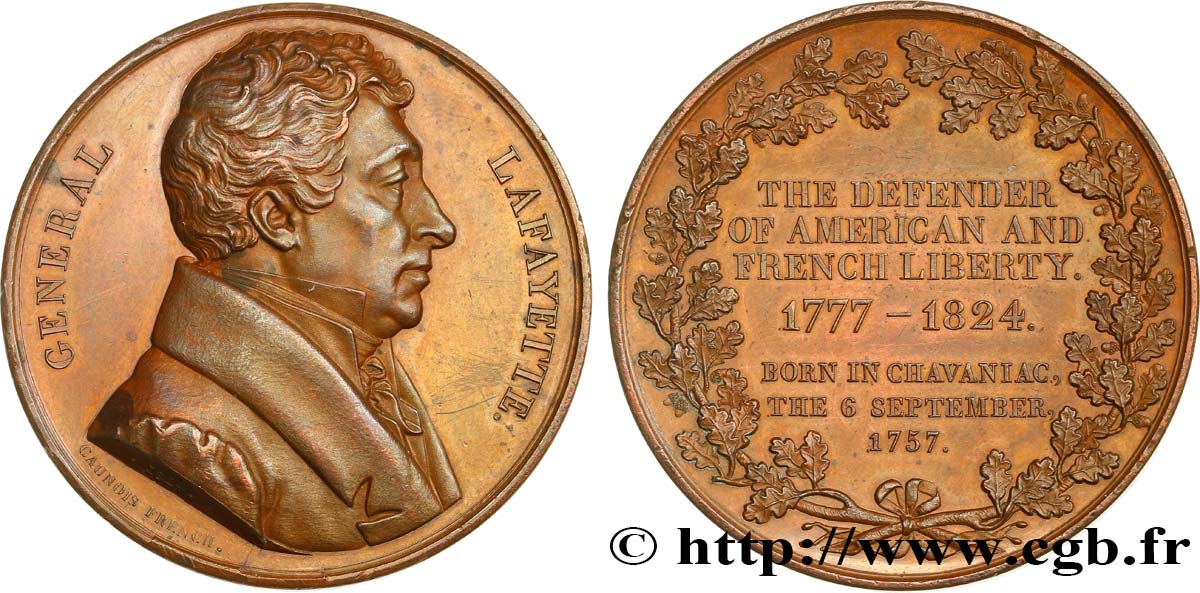
 Informar de un error
Informar de un error Imprimir la página
Imprimir la página Comparte mi selección
Comparte mi selección Haz una pregunta
Haz una pregunta Consignar / vender
Consignar / vender
 Descriptivo
Descriptivo




